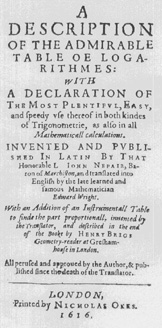|
|
Napier’s LogarithmsNapier’s idea in inventing the logarithm was to save mathematicians from having to do large calculations. These days, calculations involving large numbers are done using calculators or computers; however before these were invented, calculations like this meant that more time was taken and mistakes were made. Napier’s logarithm was not defined in terms of exponents as our logarithm is today. Instead Napier thought of his logarithm in terms of moving particles, distances and velocities. He considered two lines, AZ of fixed length and A'Z' of infinite length and points X and X' starting at A and A' moving to the right with the same initial velocity. X' has constant velocity and X has a velocity proportional to the distance from X to Z. A'X' is the Napierian logarithm of ZX. In our notation the Napierian logarithm can be defined as Nap.log y = 107 ln (107/y). Napier later worked with Henry Briggs to develop the logarithms that we use today. Together they constructed many tables of logs which have been used widely throughout the world. |
